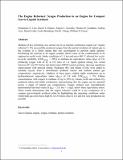| dc.contributor.author | Lim, Emmanuel Gocheco | |
| dc.contributor.author | Dames, Enoch E. | |
| dc.contributor.author | Cedrone, Kevin David | |
| dc.contributor.author | Acocella, Angela Josephine | |
| dc.contributor.author | Needham, Thomas R. | |
| dc.contributor.author | Cohn, Daniel R | |
| dc.contributor.author | Bromberg, Leslie | |
| dc.contributor.author | Cheng, Wai K | |
| dc.contributor.author | Green, William H | |
| dc.contributor.author | Arce, Andrea, S.B. Massachusetts Institute of Technology | |
| dc.date.accessioned | 2017-02-16T15:48:04Z | |
| dc.date.available | 2017-02-16T15:48:04Z | |
| dc.date.issued | 2016-03 | |
| dc.date.submitted | 2015-09 | |
| dc.identifier.issn | 0008-4034 | |
| dc.identifier.issn | 1939-019X | |
| dc.identifier.uri | http://hdl.handle.net/1721.1/106955 | |
| dc.description.abstract | Methane (CH[subscript 4]) reforming was carried out in an internal combustion engine (an “engine reformer”). We successfully produced syngas from the partial oxidation of natural gas in the cylinder of a diesel engine that was reconfigured to perform spark ignition. Performing the reaction in an engine cylinder allows some of the exothermicity to be captured as useful work. Intake conditions of 110 kPa and up to 480 °C allowed low cycle-to-cycle variability (COV[subscript nimep] < 20 %) at methane-air equivalence ratios (ϕ[subscript M]) of 2.0, producing syngas with an H[subscript 2]-to-CO ratio of 1.4. Spark ignition timing was varied between 45–30° before top-dead-center (BTDC) piston position, showing significant improvement with delayed timing. Hydrogen (H[subscript 2]) and ethane (C[subscript 2]H[subscript 6]) were added to simulate recycle from a downstream synthesis reactor and realistic natural gas compositions, respectively. Adding these gases yielded a stable combustion up to hydrocarbon-air equivalence ratios (ϕ[subscript HC]) of 2.8 with COV[subscript nimep] < 5 %. Ethane concentrations (with respect to methane) of up to 0.2 L/L (20 vol%) (with and without H[subscript 2]) produced robust and stable combustions, demonstrating that the engine can be operated across a range of natural gas compositions. Engine exhaust soot concentrations demonstrated elevated values at ϕ[subscript HC] > 2.4, but < 1 mg/L below these equivalence ratios. These results demonstrate that the engine reformer could be a key component of a compact gas-to-liquids synthesis plant by highlighting the operating conditions under which high gas conversion, high H[subscript 2]-to-CO ratios close to 2.0, and low soot production are possible. | en_US |
| dc.description.sponsorship | United States. Advanced Research Projects Agency-Energy (Award DE-AR0000506) | en_US |
| dc.description.sponsorship | Research Triangle Initiative | en_US |
| dc.description.sponsorship | MIT Energy Initiative | en_US |
| dc.description.sponsorship | Massachusetts Institute of Technology. Tata Center for Technology and Design | en_US |
| dc.language.iso | en_US | |
| dc.publisher | Wiley Blackwell | en_US |
| dc.relation.isversionof | http://dx.doi.org/10.1002/cjce.22443 | en_US |
| dc.rights | Creative Commons Attribution-Noncommercial-Share Alike | en_US |
| dc.rights.uri | http://creativecommons.org/licenses/by-nc-sa/4.0/ | en_US |
| dc.source | Other repository | en_US |
| dc.title | The engine reformer: Syngas production in an engine for compact gas-to-liquids synthesis | en_US |
| dc.type | Article | en_US |
| dc.identifier.citation | Lim, Emmanuel G. et al. “The Engine Reformer: Syngas Production in an Engine for Compact Gas-to-Liquids Synthesis.” The Canadian Journal of Chemical Engineering 94.4 (2016): 623–635. | en_US |
| dc.contributor.department | Massachusetts Institute of Technology. Department of Chemical Engineering | en_US |
| dc.contributor.department | Massachusetts Institute of Technology. Department of Mechanical Engineering | en_US |
| dc.contributor.department | Massachusetts Institute of Technology. Engineering Systems Division | en_US |
| dc.contributor.department | Massachusetts Institute of Technology. Plasma Science and Fusion Center | en_US |
| dc.contributor.department | MIT Energy Initiative | en_US |
| dc.contributor.mitauthor | Lim, Emmanuel Gocheco | |
| dc.contributor.mitauthor | Dames, Enoch E. | |
| dc.contributor.mitauthor | Cedrone, Kevin David | |
| dc.contributor.mitauthor | Acocella, Angela Josephine | |
| dc.contributor.mitauthor | Needham, Thomas R. | |
| dc.contributor.mitauthor | Arce, Andrea | |
| dc.contributor.mitauthor | Cohn, Daniel R | |
| dc.contributor.mitauthor | Bromberg, Leslie | |
| dc.contributor.mitauthor | Cheng, Wai K | |
| dc.contributor.mitauthor | Green, William H | |
| dc.relation.journal | The Canadian Journal of Chemical Engineering | en_US |
| dc.eprint.version | Author's final manuscript | en_US |
| dc.type.uri | http://purl.org/eprint/type/JournalArticle | en_US |
| eprint.status | http://purl.org/eprint/status/PeerReviewed | en_US |
| dspace.orderedauthors | Lim, Emmanuel G.; Dames, Enoch E.; Cedrone, Kevin D.; Acocella, Angela J.; Needham, Thomas R.; Arce, Andrea; Cohn, Daniel R.; Bromberg, Leslie; Cheng, Wai K.; Green, William H. | en_US |
| dspace.embargo.terms | N | en_US |
| dc.identifier.orcid | https://orcid.org/0000-0002-6295-7807 | |
| dc.identifier.orcid | https://orcid.org/0000-0002-7044-8156 | |
| dspace.mitauthor.error | true | |
| mit.license | OPEN_ACCESS_POLICY | en_US |
| mit.metadata.status | Complete | |
